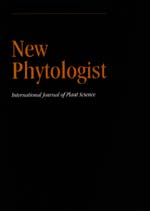Crossref Citations
This article has been cited by the following publications. This list is generated based on data provided by
Crossref.
Milberg, Per
Pérez‐Fernández, María A.
and
Lamont, Byron B.
1998.
Seedling growth response to added nutrients depends on seed size in three woody genera.
Journal of Ecology,
Vol. 86,
Issue. 4,
p.
624.
Lamont, Byron B.
Groom, Philip K.
Richards, Michael B.
and
Witkowski, E. T. F.
1999.
Recovery ofBanksiaandHakeacommunities after fire in mediterranean Australia—the role of species identity and functional attributes.
Diversity and Distributions,
Vol. 5,
Issue. 1-2,
p.
15.
Lamont, Byron B.
and
Enright, N. J.
2000.
Adaptive advantages of aerial seed banks.
Plant Species Biology,
Vol. 15,
Issue. 2,
p.
157.
Baloch, Hameed A.
Tommaso, Antonio Di
and
Watson, Alan K.
2001.
Intrapopulation variation in Abutilon theophrasti seed mass and its relationship to seed germinability.
Seed Science Research,
Vol. 11,
Issue. 4,
p.
335.
Tonioli, Maddalena
Escarré, Joseph
Lepart, Jacques
and
Speranza, Maria
2001.
Facilitation and competition affecting the regeneration ofQuercus pubescensWilld..
Écoscience,
Vol. 8,
Issue. 3,
p.
381.
Bruun, Hans Henrik
Van Rossum, Fabienne
and
Ström, Lena
2001.
Exudation of low molecular weight organic acids by germinating seeds of two edaphic ecotypes of Silene nutans L..
Acta Oecologica,
Vol. 22,
Issue. 5-6,
p.
285.
Vaughton, Glenda
and
Ramsey, Mike
2001.
Relationships between Seed Mass, Seed Nutrients, and Seedling Growth in Banksia cunninghamii (Proteaceae).
International Journal of Plant Sciences,
Vol. 162,
Issue. 3,
p.
599.
Schütz, Wolfgang
Milberg, Per
and
Lamont, Byron B.
2002.
Germination requirements and seedling responses to water availability and soil type in four eucalypt species.
Acta Oecologica,
Vol. 23,
Issue. 1,
p.
23.
Lamont, Byron B.
and
Groom, Philip K.
2002.
Green cotyledons of two Hakea species control seedling mass and morphology by supplying mineral nutrients rather than organic compounds.
New Phytologist,
Vol. 153,
Issue. 1,
p.
101.
Shen, Jianbo
Zhang, Fusuo
Chen, Qing
Rengel, Zdenko
Tang, Caixian
and
Song, Chongxin
2002.
GENOTYPIC DIFFERENCE IN SEED IRON CONTENT AND EARLY RESPONSES TO IRON DEFICIENCY IN WHEAT.
Journal of Plant Nutrition,
Vol. 25,
Issue. 8,
p.
1631.
Bayuelo-Jiménez, Jeannette S
Debouck, Daniel G
and
Lynch, Jonathan P
2003.
Growth, gas exchange, water relations, and ion composition of Phaseolus species grown under saline conditions.
Field Crops Research,
Vol. 80,
Issue. 3,
p.
207.
Campbell, Daniel R.
and
Rochefort, Line
2003.
Germination and seedling growth of bog plants in relation to the recolonization of milled peatlands.
Plant Ecology,
Vol. 169,
Issue. 1,
p.
71.
Kitajima, Kaoru
2003.
Impact of Cotyledon and Leaf Removal on Seedling Survival in Three Tree Species with Contrasting Cotyledon Functions1.
BIOTROPICA,
Vol. 35,
Issue. 3,
p.
429.
Kitajima, Kaoru
2003.
Impact of Cotyledon and Leaf Removal on Seedling Survival in Three Tree Species with Contrasting Cotyledon Functions1.
Biotropica,
Vol. 35,
Issue. 3,
p.
429.
Khurana, Ekta
and
Singh, J.S.
2004.
Response of five dry tropical tree seedlings to elevated CO2: Impact of seed size and successional status.
New Forests,
Vol. 27,
Issue. 2,
p.
139.
Griffen, Lauren R.
Wilczek, Amity M.
and
Bazzaz, Fakhri A.
2004.
UV‐B affects within‐seed biomass allocation and chemical provisioning.
New Phytologist,
Vol. 162,
Issue. 1,
p.
167.
GREEN, PETER T.
and
JUNIPER, PETER A.
2004.
Seed–seedling allometry in tropical rain forest trees: seed mass‐related patterns of resource allocation and the ‘reserve effect’.
Journal of Ecology,
Vol. 92,
Issue. 3,
p.
397.
Causin, Humberto F
2004.
Responses to shading in Chenopodium album: the effect of the maternal environment and the N source supplied.
Canadian Journal of Botany,
Vol. 82,
Issue. 9,
p.
1371.
Althoff, David M.
Segraves, Kari A.
and
Sparks, Jed P.
2004.
Characterizing the interaction between the bogus yucca moth and yuccas: do bogus yucca moths impact yucca reproductive success?.
Oecologia,
Vol. 140,
Issue. 2,
p.
321.
Khurana, Ekta
and
Singh, J S
2004.
Impact of elevated nitrogen inputs on seedling growth of five dry tropical tree species as affected by life-history traits.
Canadian Journal of Botany,
Vol. 82,
Issue. 2,
p.
158.

